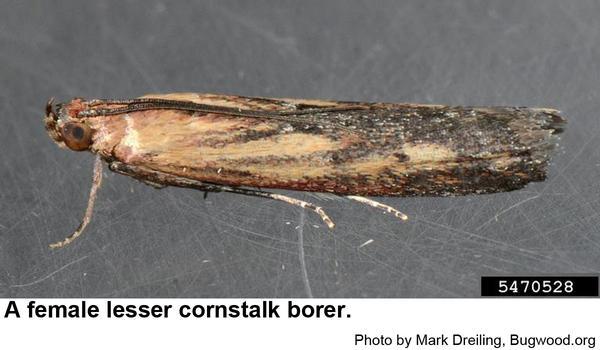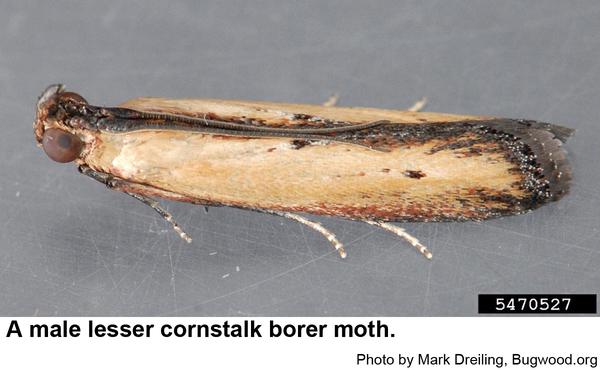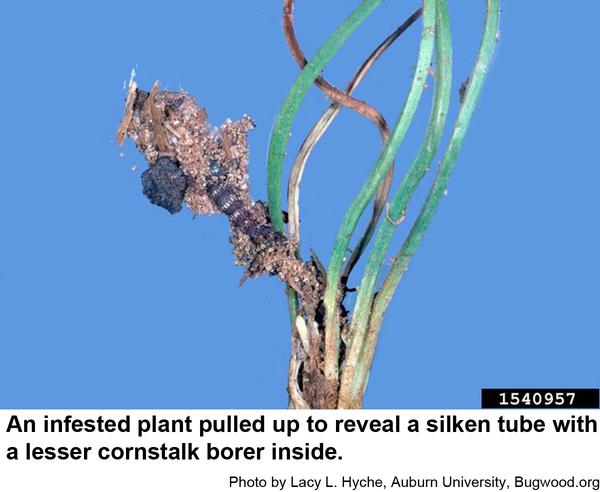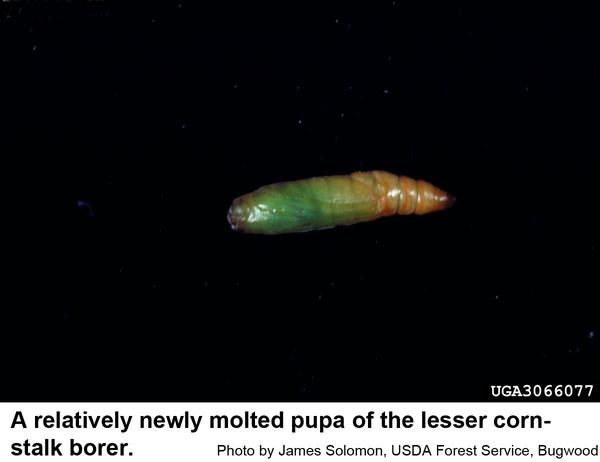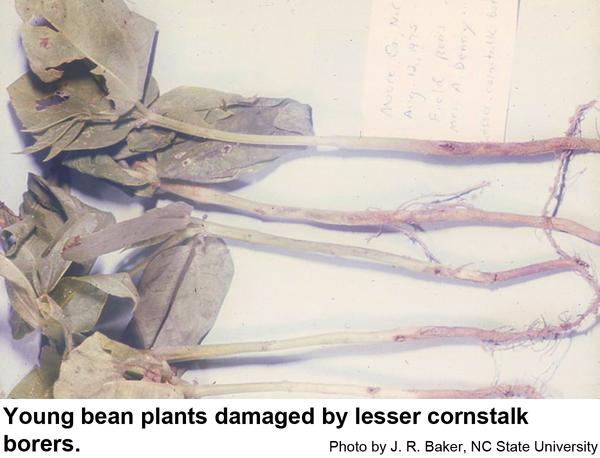Description and Biology
Moths of the lesser cornstalk borer, Elasmopalpus lignosellus, fly from June to November. The moths are about 1/2 inch long at rest with their wings wrapped tightly. Females are relatively dark whereas males are noticeably lighter. Overwintering apparently occurs as borers or pupae. Moths emerge in early spring and females lay eggs on leaves or stems or in soil close to a host plant. Three to seven days later, eggs hatch and the tiny caterpillars feed on leaves or roots. Later they construct underground burrows lined with silk from which they bore into plants near the ground line. They leave the tunnel to feed in the basal stalk area or just beneath the soil surface, returning and constructing new tunnels as they mature. Thus, tunnels often radiate out from the stem just below the soil surface. The slender, bluish-green caterpillars with brown rings around the body grow up to 7/8 inch long in 2 to 3 weeks . Mature borers spin 3/4 inch silken cocoons at the end of a silken tube or under plant material on the soil surface. During the growing season, the borers soon pupate. The slender, 7/16 inch long pupae are pale initially but darken just before adults emerge 9 to 21 days later. Pupae are slender with six hooked spines at the tip of the abdomen. A complete life cycle usually requires 30 to 60 days, but generations overlap considerably. At least two generations occur each year in North Carolina.
Host Plants
The lesser cornstalk borer is a fairly common pest of corn, and sorghum, and it attacks other grasses including crabgrass and Johnson grass (where it is beneficial) and ornamental grasses such as Miscanthus (where it is a pest!). Lesser cornstalk borers also attack beans, peas, peanuts, and soybeans. Any ornamental grass growing in sandy soil or in highway medians that are not irrigated in dry weather are likely to become infested.
Residential Recommendations
Frequent irrigation helps suppress lesser cornstalk borer because moist soils discourage female moths from laying eggs as well as encourage fungal pathogens in the soil that attack caterpillars. University of Florida observations suggest that mulching may reduce incidence of lesser cornstalk borer attack as well. Several insecticides are labeled for caterpillar control in the landscape, but getting the pesticide down to where these borers are feeding can be a challenge. Systemic insecticides such as imidacloprid are labeled for residential landscapes and should be toxic to lesser cornstalk borers. Granular formulations can be applied to the soil surface and watered in. Be sure to follow directions for safe use found on the pesticide label. Most big box stores, garden centers, and nurseries carry pesticides labeled for landscape pest suppression.
Other Resources
- Common name: lesser cornstalk borer, scientific name: Elasmopalpus lignosellus (Zeller) (Insecta: Lepidoptera: Pyralidae). Gill, H. K., J. L. Capinera and R. McSorley. 2024 (copyright). Entomology & Nematology, FDACS/DPI, EDIS. Publication Number: EENY-155.
- Insect and Related Pests of Vegetables. Sorensen, K. A. and J. R. Baker eds. 1994. NC State Extension publication AG-295. 180 pp.
- Lesser Cornstalk Borer in Soybean. Reisig, D. 2020. NC State Extension Publications.
- NC State Extension Plant Pathology Publications
- NC State Horticultural Science Publications
- North Carolina Agricultural Chemicals Manual
For assistance with a specific problem, contact your local Cooperative Extension center.
This factsheet has not been peer reviewed.
Publication date: Aug. 10, 2020
Reviewed/Revised: May 20, 2025
Recommendations for the use of agricultural chemicals are included in this publication as a convenience to the reader. The use of brand names and any mention or listing of commercial products or services in this publication does not imply endorsement by NC State University or N.C. A&T State University nor discrimination against similar products or services not mentioned. Individuals who use agricultural chemicals are responsible for ensuring that the intended use complies with current regulations and conforms to the product label. Be sure to obtain current information about usage regulations and examine a current product label before applying any chemical. For assistance, contact your local N.C. Cooperative Extension county center.
N.C. Cooperative Extension prohibits discrimination and harassment regardless of age, color, disability, family and marital status, gender identity, national origin, political beliefs, race, religion, sex (including pregnancy), sexual orientation and veteran status.

